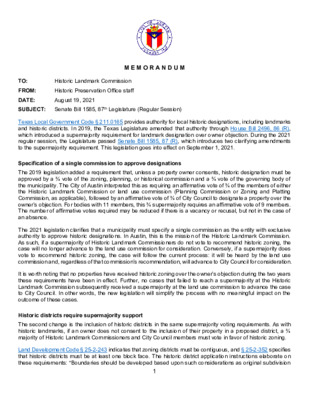4.B - Memo on Senate Bill 1585, 87 (R) — original pdf
Backup

M E M O R A N D U M TO: FROM: DATE: Historic Landmark Commission Historic Preservation Office staff August 19, 2021 SUBJECT: Senate Bill 1585, 87th Legislature (Regular Session) Texas Local Government Code § 211.0165 provides authority for local historic designations, including landmarks and historic districts. In 2019, the Texas Legislature amended that authority through House Bill 2496, 86 (R), which introduced a supermajority requirement for landmark designation over owner objection. During the 2021 regular session, the Legislature passed Senate Bill 1585, 87 (R), which introduces two clarifying amendments to the supermajority requirement. This legislation goes into effect on September 1, 2021. Specification of a single commission to approve designations The 2019 legislation added a requirement that, unless a property owner consents, historic designation must be approved by a ¾ vote of the zoning, planning, or historical commission and a ¾ vote of the governing body of the municipality. The City of Austin interpreted this as requiring an affirmative vote of ¾ of the members of either the Historic Landmark Commission or land use commission (Planning Commission or Zoning and Platting Commission, as applicable), followed by an affirmative vote of ¾ of City Council to designate a property over the owner’s objection. For bodies with 11 members, this ¾ supermajority requires an affirmative vote of 9 members. The number of affirmative votes required may be reduced if there is a vacancy or recusal, but not in the case of an absence. The 2021 legislation clarifies that a municipality must specify a single commission as the entity with exclusive authority to approve historic designations. In Austin, this is the mission of the Historic Landmark Commission. As such, if a supermajority of Historic Landmark Commissioners do not vote to recommend historic zoning, the case will no longer advance to the land use commission for consideration. Conversely, if a supermajority does vote to recommend historic zoning, the case will follow the current process: it will be heard by the land use commission and, regardless of that commission’s recommendation, will advance to City Council for consideration. It is worth noting that no properties have received historic zoning over the owner’s objection during the two years these requirements have been in effect. Further, no cases that failed to reach a supermajority at the Historic Landmark Commission subsequently received a supermajority at the land use commission to advance the case to City Council. In other words, the new legislation will simplify the process with no meaningful impact on the outcome of these cases. Historic districts require supermajority support The second change is the inclusion of historic districts in the same supermajority voting requirements. As with historic landmarks, if an owner does not consent to the inclusion of their property in a proposed district, a ¾ majority of Historic Landmark Commissioners and City Council members must vote in favor of historic zoning. Land Development Code § 25-2-243 indicates that zoning districts must be contiguous, and § 25-2-352 specifies that historic districts must be at least one block face. The historic district application instructions elaborate on these requirements: “Boundaries should be developed based upon such considerations as original subdivision 1 lines, physical or geographic characteristics, identity as a neighborhood, or historic ownership and must be supported by the historic context narrative. Retention of historical integrity must also be considered. Boundaries of the district may exclude portions of the original subdivision that lack sufficient integrity, or add adjacent subdivisions if there is sufficient unity of architecture and history. Boundaries cannot be drawn in such a way as to include ‘donut holes’ and cannot be smaller than one block-face.” Exclusion of properties at the perimeter of a proposed historic district can be evaluated by the Historic Landmark Commission on a case-by-case basis and may be appropriate for non-contributing properties with owner objection. Due to the prohibition on “donut holes,” the objection of one or more owners in the middle of a proposed district necessarily triggers supermajority voting requirements for historic zoning of the entire district. 2